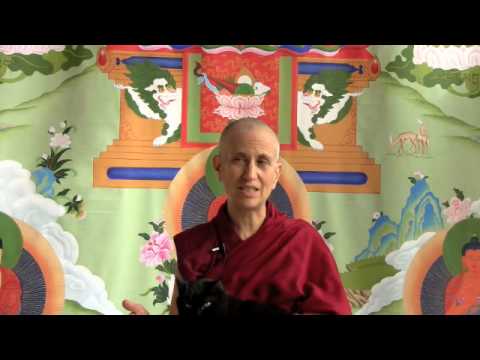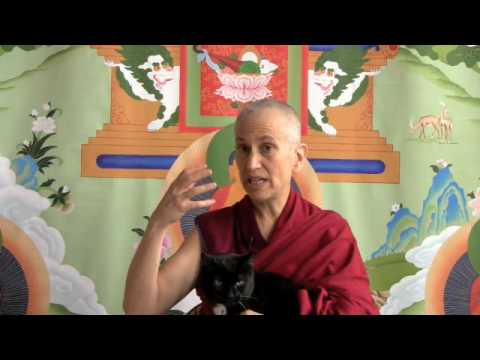Working with the Tara sadhana
Part of a series of Bodhisattva's Breakfast Corner talks given during the Green Tara Winter Retreat from December 2009 to March 2010.
- Finding ways to keep it fresh during long retreat
- We sometimes box ourselves in with overly critical attitudes toward meditation
Green Tara Retreat 054: Working with the sadhana (download)
I want to talk a little bit today about the retreat and meditation and doing the sadhana. Sometimes it happens after you have been doing the same sadhana for a while, especially in a retreat situation, you begin to feel like you are just doing the same old thing all the time. “Again and again and again, I know this prayer, yeah, yeah, yeah.” You get in a mental mode where you say, “Well, the sadhana is this recipe, and I have got to do it exactly like it says: do this here, and that there, and Tara’s scarves have to be wrapped around exactly the way they are in the painting and they have to be the same color as in the painting. Otherwise, I am doing it WRONG.”
We will get into this kind of thing, and, “Am I doing the sadhana right because I stop at this point and meditate for a while?” Somehow our mind gets very rigid into a right way and a wrong way of doing the practice. Then we start struggling mentally in our practice thinking, “I need some room here.” We are the one who is building the box by saying, “I can only do it like this.”
This is what I find very nice, when we have the retreats, when people come and different people lead the meditations. People will really be creative, and they will really think of how to make this part of themselves, and something real and meaningful because they are presenting it to the group. They do that for their own practice which helps them, instead of boxing themselves in. I think in our meditation we have to have this feeling of making something our own and being able to adjust things and flow with it. If you start imagining Green Tara as pink and she is standing in a totally different position you are going too far. In the sense of making the practice your own so it feels comfortable for you to do, then, okay.
I think we have to be on the lookout for this kind of butchered way of thinking, not only in our practice but also how we live together too. We will get into the things of, “Well, this is the way we do it at Sravasti Abbey, folks.” “You put your fork here and you put your spoon there, and don’t you dare put your fork on this side and your spoon on that side.” We will get into this very rigid state of mind that is on the lookout for how everybody else is not doing it right. This frame of mind also turns in and criticizes our self as well.
It will happen with regard to our meditation practice. “Oh, I’m not doing the sadhana right, no wonder…” and then in our life, “I’m not doing this right and they’re not doing it right either.” The mind just becomes so tight and so unhappy. That is not what Dharma practice is about, is it? If you want to be tight and unhappy, there are plenty of jobs out there that will assist you in doing it.
When we come here, we shouldn’t assist ourselves or assist each other in becoming rigid. There should be a certain amount of flowing, and give and take, and humor in the whole thing. Just remember this as you practice, and as we live together in community. There are certain kinds of guidelines but this isn’t boot camp.
So in our own mind just relaxing: you look at Tara or you look at Medicine Buddha, and their minds are relaxed. If you are visualizing Tara, and Tara instead of this serene Tara position is like this staring down at you and scowling, then think about what you are doing! Just breathe, and take a walk, and loosen up a bit.
Venerable Thubten Chodron
Venerable Chodron emphasizes the practical application of Buddha’s teachings in our daily lives and is especially skilled at explaining them in ways easily understood and practiced by Westerners. She is well known for her warm, humorous, and lucid teachings. She was ordained as a Buddhist nun in 1977 by Kyabje Ling Rinpoche in Dharamsala, India, and in 1986 she received bhikshuni (full) ordination in Taiwan. Read her full bio.


